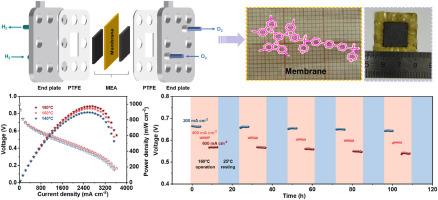Localized covalent crosslinking of poly(p-terphenyl pyridine) by radial 1,3,5-tricarbazolylbenzenes for preparation of high-temperature proton exchange membranes
IF 9
1区 工程技术
Q1 ENGINEERING, CHEMICAL
引用次数: 0
Abstract
High-temperature proton exchange membranes (HT-PEMs) with excellent swelling resistance are highly desirable to promote the safety, reliability and durability of fuel cells. Herein, we propose poly (p-terphenyl co 1,3,5-tri (9H-carbazol-9-yl) benzene pyridine) polymers (PTP/x%TCB, x refers to the crosslinking degree) featuring locally high-density crosslinking network structure. These crosslinked membranes exhibit the same solubility as that corresponded pristine membranes in commonly used organic solvents. This is different from the prepared membranes with the conventional crosslinking networks. Moreover, the prepared PTP/x%TCB membranes preserve sufficient free volume for phosphoric acid (PA) doping and ion conduction as proved by free volume fraction of the membrane. The volume swelling ratio of PTP/2%TCB membrane decreases by 50 % compared to that of the PTP membrane having the same PA uptake of 206 wt%. This indicates that the locally high-density crosslinking structure can effectively inhibit the plasticizing effect of the doped PA. The acid-doped PTP/2%TCB membrane delivers a proton conductivity of 123 mS cm−1 at 160°C. This membrane-based H2/O2 fuel cell exhibits a peak power density of 972 mW cm−2 and a specific power of 1620 mW mg−1 (Pt loading: 0.6 mg cm−2) without backpressure. Additionally, more fuel cell demonstrations with backpressure of 2.5 bar for both anode and cathode, as well as durability test at different current densities with start-stop cycling operation are made.

径向1,3,5-三氨基苯基苯局部共价交联制备高温质子交换膜
高温质子交换膜具有优异的抗膨胀性能,是提高燃料电池安全性、可靠性和耐久性的理想材料。本文提出了具有局部高密度交联网络结构的聚(对terphenyl co 1,3,5-三(9H-carbazol-9-yl)苯吡啶聚合物(PTP/x%TCB, x为交联度)。这些交联膜在常用的有机溶剂中表现出与原始膜相同的溶解度。这与用传统交联网络制备的膜不同。此外,制备的PTP/x%TCB膜的自由体积分数证明,制备的PTP/x%TCB膜为磷酸(PA)掺杂和离子传导保留了足够的自由体积。PTP/2%TCB膜的体积膨胀比相同PA吸收量为206%的PTP膜的体积膨胀率降低了50%。这表明局部高密度交联结构可以有效抑制掺杂PA的塑化作用。在160℃下,酸掺杂的PTP/2%TCB膜的质子电导率为123 mS cm−1。该膜基H2/O2燃料电池在无背压情况下的峰值功率密度为972 mW cm - 2,比功率为1620 mW mg - 1(铂负载:0.6 mg cm - 2)。此外,还进行了更多阳极和阴极背压均为2.5 bar的燃料电池演示,以及不同电流密度下启停循环操作的耐久性测试。
本文章由计算机程序翻译,如有差异,请以英文原文为准。
求助全文
约1分钟内获得全文
求助全文
来源期刊

Journal of Membrane Science
工程技术-高分子科学
CiteScore
17.10
自引率
17.90%
发文量
1031
审稿时长
2.5 months
期刊介绍:
The Journal of Membrane Science is a publication that focuses on membrane systems and is aimed at academic and industrial chemists, chemical engineers, materials scientists, and membranologists. It publishes original research and reviews on various aspects of membrane transport, membrane formation/structure, fouling, module/process design, and processes/applications. The journal primarily focuses on the structure, function, and performance of non-biological membranes but also includes papers that relate to biological membranes. The Journal of Membrane Science publishes Full Text Papers, State-of-the-Art Reviews, Letters to the Editor, and Perspectives.
 求助内容:
求助内容: 应助结果提醒方式:
应助结果提醒方式:


